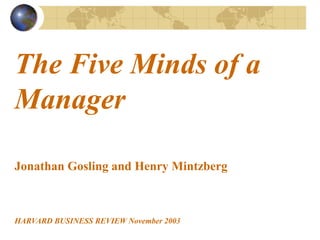
The Five Managerial Mindsets.ppt
- 1. The Five Minds of a Manager Jonathan Gosling and Henry Mintzberg HARVARD BUSINESS REVIEW November 2003
- 2. The Five Managerial Mind-Sets • the reflective mind-set • the analytic mind-set • the worldly mind-set • the collaborative mind- set • the action mind-set
- 3. The Need for Reflective Mind-Set Everything that every effective manager does is sandwiched between action on the ground and reflection in the abstract. Action without reflection is thoughtless; reflection without action is passive.
- 5. The Need for Reflective Mind-Set Managers need to step back from the pressures of their jobs and reflect thoughtfully on their experiences.
- 6. The Reflective Mind-Set - Most people do not accumulate a body of experience. Most people go through life undergoing a series of happenings, which pass through their systems undigested. - Happenings become experiences when they are digested, when they are reflected on, related to general patterns, and synthesized.
- 8. The Reflective Mind-Set society (history, economy, ethics, spirituality) organization (culture, structure, knowledge) relationships (with others, with groups) job (managerial work, managing self, managing time) self (experience, style)
- 9. The Analytical Mind-Set Good analysis provides a language for organizing; it allows people to share an understanding of what is driving their efforts; it provides measures for performance. And organizational structure itself is fundamentally analytic- it is a means of decomposition to establish the division of labor. They analyzed the analyses of others- where these people were coming from, what data and assumptions they were using.
- 10. The Analytical Mind-Set The problem for many managers today, as well as the business schools that train them, is not a lack of analysis but too much of it - at least, too much conventional analysis. How many reports have you written so far?
- 11. ManagingOrganizations:TheAnalytical Mind-Set Evaluation of Data Cause-Effect Relationships Breaking into Components
- 12. The Worldly Mind-Set We should be getting into worlds beyond our own-into other people's circumstances, habits, cultures - so that we can better know our own world. Being worldly does not require global coverage, just as global coverage does not a worldly mind-set make.
- 13. The Worldly Mind-Set To manage context is to manage on the edges, between the organization and the various worlds that surround it - cultures, industries, companies.
- 14. ManagingContext: TheWorldly Mind- Set Worlds beyond our own Seeing differently out to reflect Manage Interface – cultures Responses to specific conditions
- 15. The Collaborative Mind-Set People as independent actors, detachable human "resources" or "assets“ that can be moved around, bought and sold, combined, and "downsized." That is not the collaborative mind-set. Getting into a truly collaborative mind-set means getting beyond empowerment-a word implying that the people who know the work best must somehow receive the blessing of their managers to do it - and into commitment. It also means getting away from the currently popular heroic style of managing and moving toward a more engaging style.
- 16. The Collaborative Mind-Set Leaders don't do most of the things that their organizations get done; they do not even make them get done. Rather, they help to establish the structures, conditions, and attitudes through which things get done. And that requires a collaborative mind-set. To be in a collaborative mind-set means to be inside, involved, to manage throughout.
- 17. ManagingRelationships:TheCollaborative Mind-Set Not managing people but relationships among people Listen more than talk, Feel more Do less controlling
- 18. The Collaborative Mind-Set Two Ways to Manage
- 20. The Action Mind-Set Change, to be successful, cannot follow some mechanistic schedule of steps, of formulation followed by implementation. Action and reflection have to blend in a natural flow. And that has to include collaboration.
- 21. ManagingChange:TheAction Mind-Set Develop sensitive awareness of the Situation and team capability. Set and maintain direction. Mobilize energy around things that need changing, while maintaining the rest. Not mechanistic schedule of steps. Blend Action and Reflection. Energized action means remaining curious, alert, experimental.
- 22. Weaving the Mind-Sets Together These five mind-sets do not represent hard-and-fast categories. We need distinct labels for them, but they obviously overlap, and they are more than mere words. The weaving often has to be collaborative, like the sewing, as managers come to understand one another and combine their strengths. Effective organizations tailor handsome results out of the woven mind-sets of their managers.
- 23. Weavethe FiveMind-Sets WeavingTheMind-Sets EffectivePerformance Achieve Superior Results EffectiveOrganizations Woven Mind- Sets
- 24. Discussion time: Which mindsets are in general the strongest among the Chinese managers? Which mindset(s) of the millennial managers (post 80s) have the most room for improvement? How should they proceed to do that?